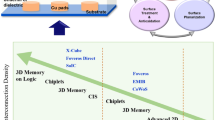Abstract
The origin of the roughness of Fin FET channel sidewalls in the heterointegration scheme was discussed. It is shown that its presence is caused by the original roughness of the Si sidewalls of the “fin” structures formed during plasma etching. A number of processing steps affecting the morphology of the Si fin structures were analyzed. The smoothing of the resistive polymeric mask in the HBr-containing plasma, distributed trimming in the layered mask, and control of the temperature conditions are among these technologies.
Similar content being viewed by others
References
Krasnikov, G.Ya., Konstruktivno-tekhnologicheskie osobennosti submikronnykh MOP-tranzistorov (Constructive and Technological Features of Submicron MOSFETs), Moscow: Tekhnosfera, 2011.
Micro- and Nanoelectronics: Emerging Device Challenges and Solutions, Brozek, T., Ed., Boca Raton, FL: CRC, 2014.
Moroz, V., Transition from planar MOSFETs to FinFETs and its impact on design and variability, Proceedings of the Berkley Seminar, October 28, 2011.
Leung, G., et al., Device-and circuit-level variability caused by line edge roughness for sub-32-nm Fin FET technologies, IEEE Trans. Electron Dev., 2012, vol. 59, no. 8, pp. 2057–2063.
Fiorenza, J.G. et al., Aspect ratio trapping: a unique technology for integrating Ge and III-Vs with silicon CMOS, ECS Trans., 2010, vol. 33, no. 6, pp. 963–976.
Kim, M.S. et al., Self-aligned double patterning of 1× nm FinFETs; a new device integration through the challenging geometry, Proceedings of the 14th IEEE International Conference on Ultimate Integration on Silicon (ULIS), 2013, pp. 101–104.
Milenin, A. et al., Patterning aspects of SiGe/Ge BFFT Fabrication, ECS Trans., 2013, vol. 50, no. 46, pp. 3–9.
Vereecke, G. et al., Characterization of modification of 193-nm photoresist by HBr plasma,” Electrochem. Solid State Lett., 2011, vol. 14, no. 10, pp. H408–H410.
Kofuji, N. et al., Line-edge roughness increase due to wiggling enhanced by initial pattern waviness, Jpn. J. Appl. Phys., 2014, vol. 53, no. 3S2, p. 03DE01.
Author information
Authors and Affiliations
Corresponding author
Additional information
Original Russian Text © G.V. Baranov, A.P. Milenin, M.P. Baklanov, 2016, published in Mikroelektronika, 2016, Vol. 45, No. 3, pp. 197–202.
Rights and permissions
About this article
Cite this article
Baranov, G.V., Milenin, A.P. & Baklanov, M.P. Investigation of the impact of plasma etching steps on the roughness of the fin FET channel sidewalls in the scheme of hetero-integration. Russ Microelectron 45, 186–190 (2016). https://doi.org/10.1134/S1063739716030033
Received:
Published:
Issue Date:
DOI: https://doi.org/10.1134/S1063739716030033




